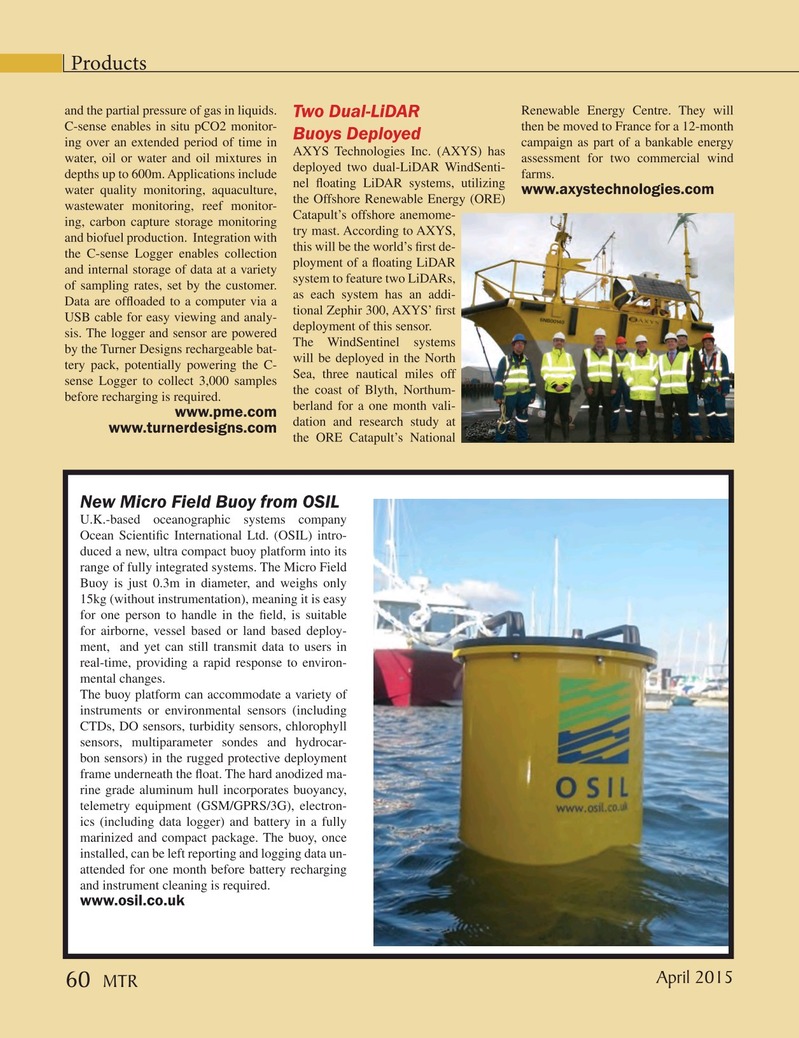
Page 60: of Marine Technology Magazine (April 2015)
Offshore Energy Annual
Read this page in Pdf, Flash or Html5 edition of April 2015 Marine Technology Magazine
Products and the partial pressure of gas in liquids. Renewable Energy Centre. They will
Two Dual-LiDAR
C-sense enables in situ pCO2 monitor- then be moved to France for a 12-month
Buoys Deployed ing over an extended period of time in campaign as part of a bankable energy water, oil or water and oil mixtures in AXYS Technologies Inc. (AXYS) has assessment for two commercial wind deployed two dual-LiDAR WindSenti- depths up to 600m. Applications include water quality monitoring, aquaculture, nel ? oating LiDAR systems, utilizing farms.
www.axystechnologies.com the Offshore Renewable Energy (ORE) wastewater monitoring, reef monitor- ing, carbon capture storage monitoring Catapult’s offshore anemome- try mast. According to AXYS, and biofuel production. Integration with the C-sense Logger enables collection this will be the world’s ? rst de- ployment of a ? oating LiDAR and internal storage of data at a variety of sampling rates, set by the customer. system to feature two LiDARs,
Data are of? oaded to a computer via a as each system has an addi- tional Zephir 300, AXYS’ ? rst
USB cable for easy viewing and analy- deployment of this sensor.
sis. The logger and sensor are powered
The WindSentinel systems by the Turner Designs rechargeable bat- will be deployed in the North tery pack, potentially powering the C- sense Logger to collect 3,000 samples Sea, three nautical miles off the coast of Blyth, Northum- before recharging is required. berland for a one month vali- www.pme.com dation and research study at www.turnerdesigns.com the ORE Catapult’s National
New Micro Field Buoy from OSIL
U.K.-based oceanographic systems company
Ocean Scienti? c International Ltd. (OSIL) intro- duced a new, ultra compact buoy platform into its range of fully integrated systems. The Micro Field
Buoy is just 0.3m in diameter, and weighs only 15kg (without instrumentation), meaning it is easy for one person to handle in the ? eld, is suitable for airborne, vessel based or land based deploy- ment, and yet can still transmit data to users in real-time, providing a rapid response to environ- mental changes.
The buoy platform can accommodate a variety of instruments or environmental sensors (including
CTDs, DO sensors, turbidity sensors, chlorophyll sensors, multiparameter sondes and hydrocar- bon sensors) in the rugged protective deployment frame underneath the ? oat. The hard anodized ma- rine grade aluminum hull incorporates buoyancy, telemetry equipment (GSM/GPRS/3G), electron- ics (including data logger) and battery in a fully marinized and compact package. The buoy, once installed, can be left reporting and logging data un- attended for one month before battery recharging and instrument cleaning is required.
www.osil.co.uk
April 2015
MTR 60
MTR #3 (50-64).indd 60 MTR #3 (50-64).indd 60 4/6/2015 4:17:33 PM4/6/2015 4:17:33 PM

 59
59

 61
61
